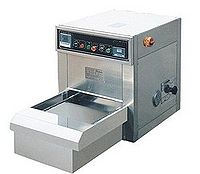Laboratory Dryers
The Laboratory Dryers follow some basic principles.
Principle
A peristaltic pump delivers liquid from the sample container to the 2 fluid nozzle mounted on the drying chamber. Compressed air from the inbuilt compressor is also supplied to the nozzle, resulting in atomization of the liquid into a fine spray. Air from the blower is heated by an electrical air heater and blown through the drying chamber. Due to the large surface area, drying is very rapid, resulting in a sharp drop in temperature. The dry powder particles are separated from the air in the cyclone separator and collected in the glass collection bottle. The exhaust air is directed through a flexible ss hose into the atmosphere. A bag filter can be provided for secondary powder collection.
Construction
- The blower, electrical air heater, air compressor and the pump are placed in a stainless steel panel, with free and easy access
- The air entering the panel is filtered through a fine cloth filter
- The chamber and cyclone are of borosilicate glass with clamp fillings, designed for easy assembly and removal
- The peristaltic pump is mounted on the front of the panel with easy accessibility
Operations
The dryer has ease of operations. The inlet air temperature is precisely controlled by the inlet temperature pid controller. The panel includes:
- Inlet temperature controller
- Outlet temperature indicator
- On/off switch and indicator for blower
- On/off switch and indicator for heater
- On/off switch and indicator for air compressor
- On/off switch and indicator for feed pump
- Pump speed control with lcd display
- Compressed air pressure control with lcd display of air pressure.
